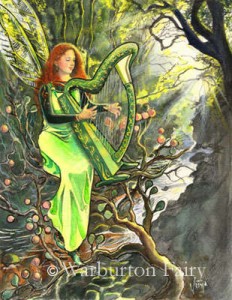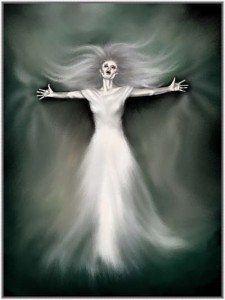 Irish folk lore is part of our heritage and the tradition of storytelling runs strongly through our veins. It would be difficult to find an Irish person who did not hear the stories of ‘Oisin in the Land of Youth’ or ‘The Children of King Lir’. In the nineteenth century Crofton Croker published ‘Fairy Legends’, Patrick Kennedy’s book ‘The Fireside stories of Ireland’ was popular and Lady Wild published ‘Ancient Legends’. An American by the name of Jeremiah Curtin also collected around twenty stories. In some cases the stories were altered for the English market and the Gaelic speaking communities, who cradled Irish folk lore, were seldom consulted. In the following century works by Douglas Hyde and Lady Gregory were widely read. Douglas Hyde was a fluent Irish speaker and Lady Gregory published works by ‘Blind Raftery of Connaught’ who is considered by many to be one of Ireland’s finest poets. Most of the published works at this time were based on stories gathered in the south, south east and west of Ireland. There are many old stories which were never put into print and this short article mentions some stories from the Finn Valley area.
Irish folk lore is part of our heritage and the tradition of storytelling runs strongly through our veins. It would be difficult to find an Irish person who did not hear the stories of ‘Oisin in the Land of Youth’ or ‘The Children of King Lir’. In the nineteenth century Crofton Croker published ‘Fairy Legends’, Patrick Kennedy’s book ‘The Fireside stories of Ireland’ was popular and Lady Wild published ‘Ancient Legends’. An American by the name of Jeremiah Curtin also collected around twenty stories. In some cases the stories were altered for the English market and the Gaelic speaking communities, who cradled Irish folk lore, were seldom consulted. In the following century works by Douglas Hyde and Lady Gregory were widely read. Douglas Hyde was a fluent Irish speaker and Lady Gregory published works by ‘Blind Raftery of Connaught’ who is considered by many to be one of Ireland’s finest poets. Most of the published works at this time were based on stories gathered in the south, south east and west of Ireland. There are many old stories which were never put into print and this short article mentions some stories from the Finn Valley area.
 Over two thousand years ago the Milesians conquered Ireland and banished the residing people, who were known as the Fir Bolg, to remote parts of the country. It is written in Irish folk lore that this was a time of supernatural people, of gods and magic. The Fir Bolg practised abstruse arts, from which they obtained the reputation of being magicians. Some believe the Fir Bolg went underground at this time and they are known today as fairies. A more popular belief is that the fairies are banished angels who refused to take sides when St. Michael crushed the rebellion in heaven.
Over two thousand years ago the Milesians conquered Ireland and banished the residing people, who were known as the Fir Bolg, to remote parts of the country. It is written in Irish folk lore that this was a time of supernatural people, of gods and magic. The Fir Bolg practised abstruse arts, from which they obtained the reputation of being magicians. Some believe the Fir Bolg went underground at this time and they are known today as fairies. A more popular belief is that the fairies are banished angels who refused to take sides when St. Michael crushed the rebellion in heaven.
In Irish mythology we hear of different creatures like the headless horseman who might be seen around midnight on certain Irish feast days. This sighting generally precedes an accident close to where vision appeared. Another creature which takes the shape of a black stallion with burning yellow eyes is said to roam the countryside at night causing damage to remote farmlands.
There is mention of the fairies secretly changing a fairy child for a human baby. This fairy child is referred to as a changeling and the fairy is only content when there is disruption in the home. There are no stories fairies of dying and the general consensus would be that they are creatures from the underworld and live forever.
The Leprechaun is perhaps one of the best known fairies whom every youngster dreams of catching as it is believed he has the power to grant three wishes in order to secure his release. However, you must be mindful of his cunning and ability to play practical jokes. The Leprechaun is a solitary creature who usually takes the appearance of a small elderly man dressed in a green or red coat. He enjoys mending shoes and counting his money. We would all like to have his pot of gold.
The Banshee is also from the fairy world and she injects fear into those who see or hear her. People who have seen the Banshee say her appearance is ghostly and her frightful crying is the foretelling of a local death.
You will find someone in every town and village in Ireland who will have yarns about the activities of fairies in the area. The fairies have been active in Donegal for generations and taking into account that there have been claims of recent sightings, it would appear they have no intention of moving out anytime soon.
In the Stranorlar area around seventy years ago a young man had an unusual experience with a Banshee. He was walking into the town when the eerie sight of the Banshee confronted him. The unusual thing about this encounter was that the Banshee was not crying her usual death song, she was completely silent. The man was in his twenties and if the shock of seeing the Banshee was not enough then what happened next probably would have scared the life out of an older person. As he sprinted as fast as his body would permit towards the town he saw a woman approaching from the Main Street. As he closed the gap to around twenty yards he recognised the woman. She had been dead for over a year. He fell to the ground with shock and when he got up the woman had vanished. It was then he heard the crying of the Banshee behind him. Later that night the dead woman’s husband died.
Some people believe in spirits and most would agree that they cannot harm you. In Ireland, It is said that spirits like the headless horseman and the banshee can only occasionally be seen by people with old Gaelic surnames.
It is only fair to mention that probably the majority of people would view such claims with some scepticism but how many of us would rush to pull down a fairy fort? There is a wider belief that the unusual phenomena of three knocks preceding a family death is a sign from the spirit world.
In more recent times a young farmer had a chance meeting with a fairy between Ballybofey and Letterkenny. He was walking in a neighbour’s field with his dog and dragging a stick along the grass beside a stream. All of a sudden a very small man raced up the stick at speed, ran across the farmer’s shoulders and jumped on to the dog’s tail. He proceeded to race at lightening speed to the tip of the dog’s nose whereupon he jumped and disappeared into the stream. The dog took off and rather than race towards the gate, he headed for the nearest ditch and ran clean through it in order to make a hasty escape. When the farmer’s wife saw the dog scratching frantically at the door to get inside, she knew something had happened. Later when her husband got home and had time to settle his nerves, the only explanation he had was that he must have surprised the fairy sleeping beside the burn. The farmer or the dog never entered the field again.
The following story was told in the Gaelic language and handed down for many generations in the Glenfinn area.
Many years ago a family residing in the Cloghan area had a double encounter with the fairies. One evening in a small farm house, the farmer’s wife was doing the usual household chores when she heard a tapping sound behind her in the pantry. When she turned around a small man about a foot tall, dressed in a green suit with green buckled shoes, was standing there. Although she was frightened, she sensed he meant her no harm as he had his hands behind his back and he was tapping his foot on the ground. ‘Don’t be afraid, I mean you no harm’ he said. The woman asked him what he wanted and he said ‘The waste water you are throwing out the back door every day is running into our fort. Walk twenty paces towards the oak tree before you dump it and you’ll have good luck.’ With that he was gone and the woman did as the fairy had asked from then on.
The small farm was not the best of land and animals often got sick. On top of this, the woman’s husband was fond of the cards and drink and she was left mostly on her own to run the farm and rear the children. One evening after he sold stock at a fair in Stranorlar he hit the bottle and went to a card game in the town land of Drim. His was a poor card player and around three in the morning when his money was gone; he bid the party farewell and started home. There is an old saying that it is unlucky to carry cards across a bridge after twelve o clock at night and when he reached Drim Bridge he heard a tapping sound behind him. As he looked around, he could see in the moonlight around thirty fairies and the fairy in front was dressed in a green suit with green buckled shoes. He was tapping a leather football with ease on the road and as the man turned to run, the fairy let rip and struck him on the head with the ball. The man ran for miles and the fairies followed, competing for every kick and striking their target with every blow. He never drank or played cards after that night and the family fortunes greatly improved from then on. For many years after this incident few people would walk the Drim Road, which stretches for about two miles, after dark.
There are many who would say that these tales were nothing more than fireside stories which were popular at a time before Edison invented the light bulb. But it could be said that there is at least a moral to each story. You shouldn’t enter your neighbour’s field, play cards after twelve o clock at night, have alcohol taken crossing Drim Bridge or throw water outside your back door. Other people would say that there is a fine line between fact and fiction and we see this in our history going back over two thousand years. Some historians believe that Finn Mac Cumhail did exist, but the stories surrounding him in Irish folk lore were blown out of such proportion that he sometimes is referred to as being a giant. Stories surrounding St Patrick are also mixed with Irish folk lore. But leaving aside ones beliefs, there is no denying that the Irish Leprechaun is probably Ireland’s best ambassador appearing in books, in films and marching in major cities all over the world on the seventeenth of March each year.


